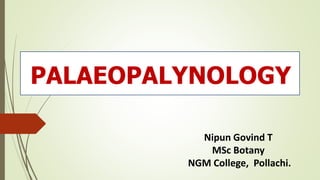
Palaeopalynology; Definition, History, Methods and Benefits of study
- 1. PALAEOPALYNOLOGY Nipun Govind T MSc Botany NGM College, Pollachi.
- 2. What Is Palaeopalynology? Palynology is the study of plant pollen, spores and certain microscopic planktonic organisms (collectively called palynomorphs) in both living and fossil form. Palaeopalynology is one of the disciplines of palynology and concerned with the study of fossil pollen grains and spores.
- 4. History of Palaeopalynology Paleopalynology was established at the end of the nineteenth century, when P. Reinsch published the first photomicrographs of fossil pollen and spores from Russian coals (Reinsch 1884). He also described methods for the extraction of palynomorphs from coal samples with concentrated potassium hydroxide (KOH) and hydrofluoric acid (HF)
- 5. Palaeopalynology has become an applicative discipline of palynology due to the following features possessed by pollen grains and spores: Pollen and spores survive better and longer than other biological materials due to the presence of tough exine. The exine is mainly composed of sporopollenin that renders the pollen grains and spores resistant to decay. Grains survive well where microbial activity is depressed due to drought, low availability of oxygen and presence of toxic salts in soil.
- 6. Electron microscopic view of fossil pollen grains
- 7. The resistant exine is always ornamented/ sculptured. The ornamentation occurs in a ‘species-specific-pattern’. The size of a pollen grain and spore is small and this facilitates an ease of aerial transport to long distances. This property helps to trace the place of migration of a plant.
- 8. Pollen analysis, in comparison to megafossil studies is more advantageous by virtue of the fact that a little quantity of sample unfolds the vegetation of that area from where the samples are collected. Pollen and spores are always produced in very large numbers.
- 9. Methods in Palaeopalynology Palynologists have developed a series of standard methods that are applied to collect, extract, identify, and describe organic-walled microfossils. • Sample collection • Palynological Extraction • Palynological Sample Mounting and Observation • Palynological Analysis
- 10. 1. Sample collection Palynological sampling requires a good knowledge of sedimentology in order to identify those lithologies most likely to preserve organic matter particles of microscopic size Color of the rock is a very important indicator, as usually rocks of dark gray/black color are rich in organic matter
- 11. Organic matter and palynomorphs are destroyed by oxidizing conditions; therefore, paleosols are not good candidates, Local tectonic activity can affect the organic matter by thermal maturation. Collection of the sample is usually done using a rock hammer or a knife in case of soft rocks. Samples can conveniently be stored in air tight ziplock bags with an acid-free paper label inside
- 12. A typical stratigraphic section in the soft rocks of the lowermost part of the Fort Union Formation (southwestern North Dakota). The red stratigraphic markers indicate the contact between different lithological units. Palynological samples were collected in stratigraphic sequence from the clean surface of the highwall using a sharp knife.
- 13. 2. Palynological Extraction In the laboratory, samples are processed chemically to remove the mineral fraction of the rocks, using strong inorganic acids. Sieving is commonly done in order to remove the largest fragments as well as the smallest amorphous organic particles. Ultrasound treatment to break up agglutinated particles in the residue.
- 14. Oxidizers can also be applied, including NaOH or KOH to remove humic acids, and nitric acid or Schultze’s reagent to reduce the opacity of the organic matter Staining of samples with Safranin Red dye The residue that is obtained can then be stored in vials, either dried or in alcohol for future use.
- 15. Dyed palynological residues stored in vials. The residue is used to mount microscope slides or SEM stubs.
- 16. Palynological slides for optical microscopy observation. The dyed residue is mounted in a permanent medium for long-term preservation.
- 17. 3. Sample Mounting and Observation For optical microscopy, the material is prepared and mounted for observation on microscope glass slides. Temporary mounts can be made using glycerin jelly as a mounting medium. Modern polymers like epoxy and polyester resin display very good stability, optimum refractive index, and are very easy to use.
- 18. The poly vinyl alcohol attaches the residue to the coverslip, ensuring that the material lies on the same optical plane. Electron microscopy can be beneficial in resolving details of the surface and ornamental structure of palynomorphs at much higher magnification than optical microscopy. SEM provides three-dimensional images of the outer surface of imaged objects. Transmitted electron microscopy (TEM) is used to elucidate the internal structure through ultra thin sections roughly 100 nm thick.
- 19. A) SEM image of palynological residue showing a variety of palynodebris including a large tracheid with pitting (wood fragment) B) SEM image of Erdtmanipollis cretaceus, an uppermost Maastrichtian angiosperm pollen species from the Hell Creek Formation among palynodebris.
- 20. 3. Palynological Analysis The concept of Palynological analysis was introduced by Batten and Stead It aims at describing the proportion, shape, color, and size of every piece of organic debris (palynodebris) present on a slide. Characterizing depositional environment and taphonomy. [ Taphonomy is the study of how organisms decay and become fossilized or preserved in the archaeological record ]
- 21. Benefits of study 1. To trace the history of vegetation 2. To study plant assemblage at a specific stratigraphic horizon 3. To correlate deposits and assigning dates 4. To study climatic change 5. To study extinct genera 6. To study evolution of plants and establish affinity 7. To study past distribution of flora 8. To study palaeoecology 9. To determine coal-bearing strata 10. To define ancient shoreline
- 22. References A. Bercovici, J. Vellekoop, (2017) Methods in Paleopalynology and Palynostratigraphy: An Application to the K-Pg Boundary, Elsevier Inc. (page 127,136-140) https://www.biologydiscussion.com/palynology/notes- on-palaeopalynology-palynology/68957 https://www.floridamuseum.ufl.edu/paleobotany/palyno logy/
- 23. Thanks...